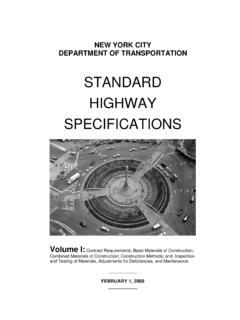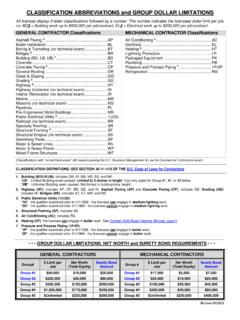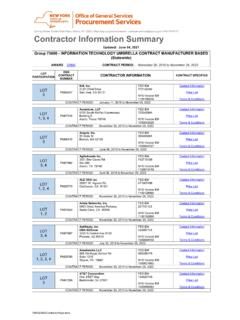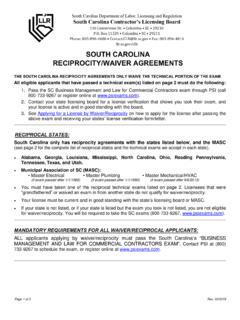Transcription of Contractor Quality Control Plans Contractor Guidelines and ...
1 Department Commitment to Excellence . of Transportation Federal Lands Highway Federal Highway Administration Contractor Quality Control Plans Contractor Guidelines and Example Quality Control Plan These Guidelines are intended to assist FLH Contractors in the preparation of acceptable Quality Control Plans . They are based on the requirements contained in Section 153 of the Standard Specifications for Construction of Roads and Bridges on Federal Highway Projects (FP). The Guidelines are not contractual requirements, and do not supplement or supersede any contractual requirements. Federal Highway Administration Federal Lands Highway Office Engineering and Operations Division (HFL-20). Washington, DC 20590. February 1998. Department Commitment to Excellence . of Transportation Federal Lands Highway Federal Highway Administration Contractor Quality Control Plans Contractor Guidelines Page A. Introduction ..2. B. FAR and FP Requirements .. 2. C. Plan Development.
2 4. 1. Organizational Structure .. 4. 2. Process Control Testing .. 4. 3. Inspection/ Control Procedures .. 5. 4. Categories of Construction .. 6. 5. Preliminary, startup and production phases .. 6. 6. Who, what, where, when and how? .. 6. 7. Subcontractors and Suppliers .. 7. 8. Manufactured Materials .. 7. 9. Records and Documentation .. 8. 10. Personnel Qualifications .. 8. 11. Partial Plans .. 8. D. Contractor Evaluation .. 8. Appendices A. Example Quality Control Plan .. 9. B. Example Good, Fair and Poor QC Plan Elements .. 15. 1. Contractor Quality Control Plans A. Introduction A Contractor Quality Control plan (CQCP) is the documentation of the Contractor 's process for delivering the level of construction Quality required by the contract. This document is intended to provide guidance to Federal Lands contractors, subcontractors and suppliers as to what is expected from CQCPs, and what the criteria for accepting and using the requirements for these Plans will be.
3 The CQCP is a framework for the Contractor 's process for delivering Quality construction. The Plans and specifications define the expected results or outcome. The CQCP outlines how those results will be achieved. While it is not possible to determine from the CQCP whether the level of construction Quality will be acceptable, it is possible to verify that the Contractor , as an organization, has addressed the basic elements of its Quality process. These Guidelines address, not only what should be in the CQCP in order for it to be acceptable to the Government, but also what elements the Government's QA process needs to have in order to assure Quality without usurping the Contractor 's responsibilities. It is not possible to determine from the content of the CQCP whether Quality construction will result. The plan is not approved, but accepted based only on whether the plan clearly addresses all the issues it is required by the contract to address. B.
4 FAR and FP Requirements FAR Clause Inspection of Construction is the foundation and basis for all contract requirements dealing with Quality Control and Quality assurance. In summary the clause: ! Requires the Contractor to maintain an adequate inspection system and perform inspections that will ensure contract compliance. ! Requires the Contractor to maintain inspection records and make them available to the Government. ! Allows [but does not require or obligate] the Government to do its own tests and inspections and requires the Contractor to assist. ! Says that Government tests and inspections are for its benefit and do not take the place of the Contractor 's Quality Control obligations. ! Says that anytime the Contractor tells the Government that work is ready for inspection and it is not [ it is in noncompliance], the Government may charge the Contractor for the costs of its inspections and tests. ! Says that the Contractor is obligated to comply with the contract whether or not a Government inspector is present.
5 ! Says that the Government may order previously completed work torn apart for inspection, and that if it is noncompliance, the Contractor will pay for the inspection and the correction of the work. If it is in compliance the Government will pay for the inspection and disruption to the work. 2. Note that nothing in the FAR clause requires that the Contractor 's inspection system be described in writing, or that it be submitted to the Government for approval in advance of the work. These requirements are contained in the FP-96, Section 153. In addition, Section 153 contains a basic outline of what should be included in the CQCP. The outline should be repeated for each major category of construction. Outline of Contractor Quality Control Plan Requirements FP-96, Subsection (a) Process Control testing. List the material to be tested, tests to be conducted, the location of sampling, and the frequency of testing. (b) Inspection/ Control procedures. Address each of the following subjects in each phase of construction: (1) Preparatory phase.
6 (a) Review all contract requirements. (b) Ensure compliance of component material to the contract requirements. (c) Coordinate all submittals including certifications. (d) Ensure capability of equipment and personnel to comply with the contract requirements. (e) Ensure preliminary testing is accomplished. (f) Coordinate surveying and staking of the work. (2) Start-up phase. (a) Review the contract requirements with personnel who will perform the work. (b) Inspect start-up of work. (c) Establish standards of workmanship. (d) Provide training as necessary. (e) Establish detailed testing schedule based on the production schedule. (3) Production phase. (a) Conduct intermittent or continuous inspection during construction to identify and correct deficiencies. (b) Inspect completed phases before scheduled Government acceptance. (c) Provide feedback and system changes to prevent repeated deficiencies. (c) Description of records. List the records to be maintained.
7 (d) Personnel qualifications. (1) Document the name, authority, relevant experience, and qualifications of person with overall responsibility for the inspection system. (2) Document the names, authority, and relevant experience of all personnel directly responsible for inspection and testing. (e) Subcontractors. Include the work of all subcontractors. If a subcontractor is to perform work under this Section, detail how that subcontractor will interface with the Contractor 's and/or other sub- Contractor 's organizations. 3. C. Plan Development Unless the Contractor already has a documented company QC plan, it may be helpful to discuss what is required, and how detailed it will be. Generally, discussion of the basic who, what, where, when and how should comprise three to six pages, with an additional two to four pages of detailed information for each major category of work. This is not including supplemental materials such as subcontractor/supplier Plans , certifications, test data and personnel r sum s.
8 Also, if the QC Plan contains a lot of repetitions of contract specifications, meaningless platitudes from Quality textbooks and other fluff, its necessary length will be longer. Quality and the processes that deliver Quality is a somewhat open ended concept. No matter how much detail is in the plan, it can always be argued that more could be, or should be included 1. Organizational Structure One of the first issues a Contractor , or any organization must face when designing its QC/QA. procedures, is how these systems will relate to, and impact its organizational structure. Separate Quality Staff - Testing is a very specialized function. A Contractor may elect to hire a separate staff or subcontractor to perform testing and to generate the documentation required by the FAR Clause and the FP. But the testing and documentation are only part of the inspection system required by the contract. If the entire inspection system is performed by personnel separate from production personnel, that would mirror the traditional relationship between Contractor and agency organizations.
9 If a Contractor has a separate Quality staff, it is important to define the relationship between those personnel and the production organization. What will be the disposition of failing tests/inspections? Who will have authority to order production ceased? Under what circumstances? What will be the conditions of restarting production? Combined Staff - Quality management experts generally discourage separating Quality Control personnel from production personnel. It pits one part of the organization against another. This built in adversity is seen as both inefficient and requiring additional staff. Ideally Quality Control should be achieved by developing an organizational culture which encourages Quality - a culture which is embraced by everyone in the organization. However, for an organization transitioning from a traditional to a Quality management system, superimposing a QC/QA staff on its existing organization may make sense while that organizational culture is being developed.
10 2. Process Control Testing Testing provides a reflection of Quality and the process. But only changes to the process can improve Quality . Extensive testing needed to identify defects so that they can be corrected is an indication of a poor process. Ideally frequencies of QC testing are dependent on characteristics of the overall process. In a transition environment however, when contractors are not used to designing comprehensive QC systems, it may be necessary for the agency to provide guide frequencies to minimize the risk of serious deficiencies undetected until late in the process. It is easy to become preoccupied with testing when describing the plan. Testing is easily defined and leaves a clear documentation trail. But the organizational resources that actually will Control the Quality of the construction are by far, the most important part of the plan, even though describing these resources and procedures [the process] in writing is often difficult.









